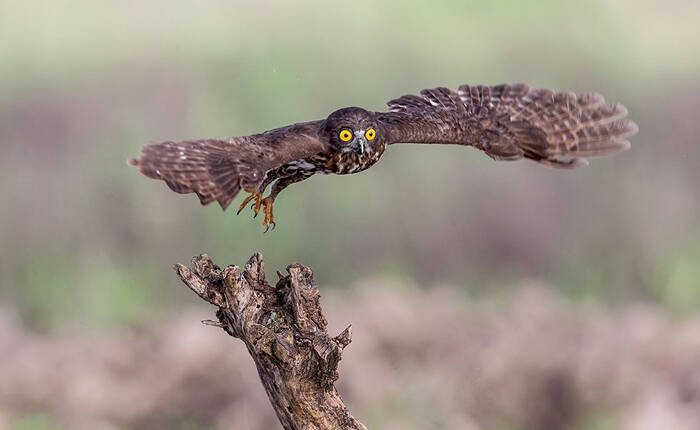Ninox scutulata
IUCN
LCBasic Information
Scientific classification
- name:Ninox scutulata
- Scientific Name:Ninox scutulata,Brown Hawk-owl,Brown Hawk-Owl
- Outline:Raptor
- Family:Strigiformes Owl
Vital signs
- length:28-31cm
- Weight:212-230g
- lifetime:About 10-20 years
Feature
It is named after its eagle-like appearance, which is also conducive to its activities during the day.
Distribution and Habitat
Origin: Bangladesh, Bhutan, Brunei Darussalam, Cambodia, China, India, Indonesia, Lao People's Democratic Republic, Malaysia, Myanmar, Nepal, Philippines, Singapore, Sri Lanka, Thailand and Vietnam.
In China, it is mainly distributed in Beijing, Liaoning, Jilin, Heilongjiang, Shanghai, Jiangsu, Fujian, Jiangxi, Shandong, Henan, Hunan, Guangdong, Guangxi, Sichuan, Yunnan, Shaanxi, Gansu, Taiwan and Hong Kong.
In China, it is a resident bird and a summer breeding migratory bird, but neither is common. At low and medium altitudes, up to 1,500 meters above sea level. Subspecies The Siberian subspecies breeds in northeastern China to central and eastern China, and migrates south for the winter; the South China subspecies is a resident bird in southern China and Hainan Island; the Japanese subspecies is a resident bird in Taiwan, including Lanyu and Penghu Islands; the Indian subspecies is a resident bird in southeastern Tibet.
It lives in mixed coniferous and broad-leaved fore
Appearance
There are no prominent facial disks, quills, or ear feather tufts that are primarily used to collect sound waves. The upper body is dark brown. The forehead is white, there are white spots on the shoulders, and the throat and front neck are yellow with brown stripes. The rest of the underparts are white with drop-shaped reddish-brown spots, and the tail feathers have black horizontal spots and end spots.
The iris is yellow, the mouth is gray-black, the tip of the mouth is dark brown, the tarsometatarsal feathers are feathered, the toes are bare, fleshy red, with sparse light yellow setae, and the claws are black.
Size measurements: body weight ♂212-220 g, ♀230 g; body length ♂290-313 mm, ♀280-313 mm; bill peak ♂14-20 mm, ♀12-17 mm; wings ♂226-234 mm, ♀ 230-240 mm; tail ♂125-140 mm, ♀121-140 mm; tarsometatarsal ♂28.5-33 mm, ♀27-31 mm. (Note: ♂ male; ♀ female)
Details
The Brown Hawk-owl is a medium-sized bird of prey with 11 subspecies.

The breeding season of the eagle owl is from May to July. It usually nests in natural caves on trees such as Populus dasyphylla and Elm cycads, and also uses tree holes used by mandarin ducks and woodpeckers. The tree holes used for nesting are relatively wide, and their width and depth vary greatly. The diameter of the nest hole is 9-30 cm, the depth of the hole is 18-64 cm, and the diameter inside the hole is 10-43 cm. There is no bedding in the nest, or only rotten sawdust in the tree hole. If it is an old nest of mandarin ducks, there will be a small amount of down feathers left in it. One nest is bred each year, with three eggs in each nest. The eggs are nearly spherical, milky white, and smooth without spots. The female bird is responsible for incubation, while the male bird is on guard near the nest. It is extremely fierce when guarding the nest, especially in the late incubation period and during the brooding period. When encountering danger, the male and female birds will take turns to launch fierce attacks on the intruders until the intruders are driven out of the territory. The incubation period is 25-26 days. The chicks are late-maturing. When they are just hatched, their eyes are closed, their bodies are covered with white fluff, their skin is flesh-red, their beaks are gray-black, and their wax membranes and claws are lead gray. They leave the nest one after another at the age of 30 days.
Listed in the "Red List of Threatened Species of the World Conservation Union" (IUCN) 2016 ver 3.1-Least Concern (LC).
Listed in China's "National Key Protected Wildlife List" (February 5, 2021) Level 2.
Protect wildlife and eliminate game.
Maintaining ecological balance is everyone's responsibility!








